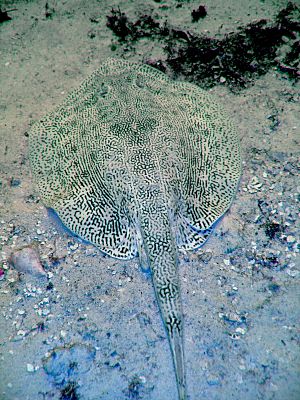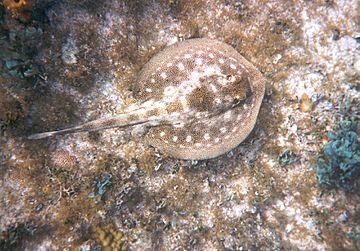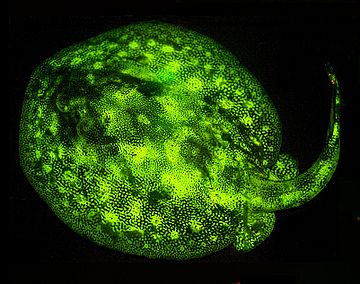Yellow stingray facts for kids
Quick facts for kids Yellow stingray |
|
|---|---|
 |
|
| Conservation status | |
| Scientific classification | |
| Genus: |
Urobatis
|
| Species: |
jamaicensis
|
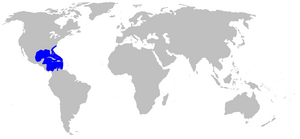 |
|
| Range of the yellow stingray | |
| Synonyms | |
The yellow stingray (Urobatis jamaicensis) is a type of stingray. It belongs to the family Urotrygonidae. You can find it in the warm, tropical western Atlantic Ocean. Its home ranges from North Carolina all the way to Trinidad.
This stingray lives on the bottom of the ocean. It likes sandy, muddy, or seagrass areas in shallow waters. You often see it near coral reefs. The yellow stingray is not very big, growing to about 36 cm (14 in) across. It has a round body and a short tail with a strong caudal fin (tail fin). Its back has a unique pattern of light and dark spots or lines. It can even change its color quickly to hide from predators!
During the day, the yellow stingray usually stays still. It eats small invertebrates (like shrimp) and small bony fishes. When hunting, it might wave its body to dig up food hidden in the sand. It can also lift the front of its body to make a "cave" to attract small animals looking for shelter. This stingray gives birth to live young. The babies grow inside the mother, first using yolk and then a special "uterine milk." Females can have two groups of babies, up to seven young, each year.
Even though it's usually harmless, the yellow stingray has a venomous spine on its tail. It can cause a painful injury if it feels threatened. People sometimes catch these stingrays by accident when fishing. They are also collected for aquariums. Losing their habitat is another problem for them. But don't worry, the yellow stingray is still common and found in many places. Because of this, the International Union for the Conservation of Nature (IUCN) says it is of "Least Concern."
Contents
Discovering the Yellow Stingray
A French naturalist named Georges Cuvier first described the yellow stingray in 1816. He called it Raia jamaicensis. He found specimens (examples) of this ray in Jamaica.
Over time, scientists changed the ray's scientific name. It was first moved to the genus Urolophus, and then to Urobatis. Some older books might still call it Urolophus jamaicensis. People also call this ray by other names, like the yellow-spotted ray, the round ray, or the maid ray.
What Does a Yellow Stingray Look Like?
The yellow stingray is a small ray. It grows to about 36 cm (14 in) wide and 70 cm (28 in) long. Its body is almost round, like a circle. It has a short, blunt nose. Right behind its eyes are two holes called spiracles. These help it breathe.
Inside its mouth, there are small bumps called papillae. It has many rows of teeth, about 30 to 34 in each jaw. The teeth of young rays and females are flat. But adult males have taller, pointy teeth. These pointy teeth help males hold onto females during mating. The pelvic fins (fins near the tail) are mostly straight with rounded edges.
The tail is thick and flat, making up less than half of the ray's total length. It ends in a small, leaf-shaped caudal fin (tail fin). About halfway down the tail, there is a sharp, serrated spine. When they are born, young rays have smooth skin. As they grow, small bumps appear on their backs. Older rays also get thorns along the top edge of their tail fin.
The color of the yellow stingray can be very different from one ray to another. Most have either dark lines on a light background or bright spots (white, yellow, or gold) on a dark background. Their underside is usually yellowish, greenish, or brownish white. It might have small dark spots near the edges of its body and on its tail. This ray is amazing because it can quickly change how light or dark its colors are to match its environment!
Where Yellow Stingrays Live
The yellow stingray lives in the shallow waters of the Gulf of Mexico and the Caribbean Sea. This includes places like Florida, the Bahamas, and the islands of the Greater and Lesser Antilles down to Trinidad. Sometimes, it travels as far north as North Carolina. It's very common in the Florida Keys and some parts of the Antilles, but less common elsewhere.
This ray lives on the bottom of the ocean, in coastal areas. It likes bays, lagoons, estuaries, and calm surf zones. You can find it from the very edge of the water down to about 25 m (82 ft) deep. It especially likes rocky areas covered with sessile invertebrates (animals that stay in one place, like sponges). But it also lives over sand, mud, or seagrass beds. Sometimes, it's found near coral reefs.
Off the coast of Jamaica, many yellow stingrays gather under mangrove trees. These trees are used by cattle egrets (birds) as resting spots. Scientists think the birds' droppings attract small creatures that the rays like to eat. There's no sign that these rays travel long distances with the seasons. However, in spring, female rays tend to be found closer to shore than males.
How Yellow Stingrays Live
During the day, yellow stingrays are pretty quiet. They spend a lot of time buried under sand or resting in plants. Studies show they usually stay in a small area, about 20,000 m2 (220,000 sq ft). They like to hang out where different types of ground meet, like where sand meets a reef.
Their eyes can see all around them, giving them a 360-degree view. Each eye has a special cover that controls how much light gets in. This helps the resting ray spot any predators coming its way. Large carnivorous fish, like the tiger shark, might try to eat them. Yellow stingrays can hear sounds best between 300 and 600 Hertz. This is typical for sharks and rays. They also have a large brain compared to other rays, about 1–2% of their body weight.
We don't know everything about what yellow stingrays eat. But we know they eat shrimps. They probably also eat worms, clams, and small bony fishes. The ray usually settles over its food and traps it against the bottom. Then, it uses its body to move the food to its mouth. Sometimes, it wiggles its body to dig up food hidden in the sand. It has also been seen lifting the front of its body to create a shaded "cave." This attracts small creatures looking for shelter.
The yellow stingray can also biofluoresce. This means that when blue or ultraviolet light shines on it, the ray glows green. This might help them talk to each other or hide better.
Life Cycle and Reproduction
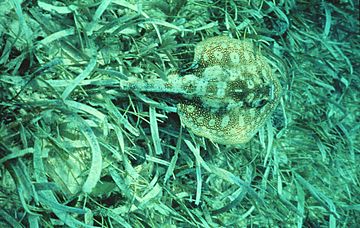
Like other stingrays, the yellow stingray gives birth to live young. This is called aplacental viviparous. At first, the baby rays get food from a yolk sac. Later, the mother provides a special "uterine milk" that is rich in nutrients. Female stingrays have two working uteruses, but they use the left one more often.
They have babies twice a year, with a gestation period (pregnancy) of 5–6 months. The first group of babies is born from June to September. The second group is born from November to January. The mother starts making new eggs while she is still pregnant with the first group of babies.
When it's time to mate, one or more male stingrays will follow a female. They try to bite and hold onto the back edge of her body. The male's pointy teeth help him do this. Once he holds on, he flips under her so they are belly-to-belly. Then, he inserts a clasper (a special organ) into her body. Other males might try to stop them by biting or bumping. One time, in Belize, a male chased a female for about 30 to 60 seconds, and mating lasted four minutes.
The baby rays grow a lot inside the mother, increasing their weight by 46 times! They are born tail-first. Newborns look like small versions of the adults, but their bodies are a bit wider. They also have a small "knob" over their spiracle that disappears soon after birth. Males are ready to have babies when they are about 15–16 cm (5.9–6.3 in) wide. Females are ready when they are about 20 cm (7.9 in) wide. Yellow stingrays can live for 15 to 25 years. Seagrass beds are very important places for them to give birth.
Yellow Stingrays and People
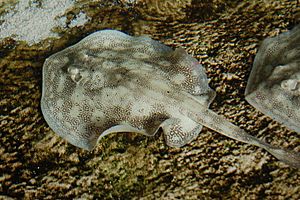
Yellow stingrays usually don't bother divers and let people get close. However, if you step on one or bother it, the ray will defend itself with its tail spine. This spine has strong venom. The sting is very painful, but it's usually not life-threatening.
These rays are small and calm, so they do well in aquariums. They have even had babies in captivity! But they need a lot of space (at least 180 gallons or 684 liters) and a deep, fine sand bottom.
The International Union for the Conservation of Nature (IUCN) says the yellow stingray is of "Least Concern." This means they are not worried about it becoming endangered. This is because it lives in many places and there are lots of them in some areas. Also, because they are small, they can have many babies, which helps their population recover from fishing. People don't usually fish for yellow stingrays on purpose. But they are sometimes caught by accident in coastal fisheries. They are also caught for the home aquarium trade. We don't know exactly how many are caught for aquariums. Another problem for them is the loss of their habitat, especially seagrass beds. Right now, there are no special plans to protect this species.
Gallery
-
A yellow stingray resting on a reef in Miami, Florida.
-
A yellow stingray at the Oregon Coast Aquarium in Newport, Oregon.
-
A yellow stingray resting under a layer of sand in Cozumel, Mexico.
See also
 In Spanish: Raya amarilla para niños
In Spanish: Raya amarilla para niños



